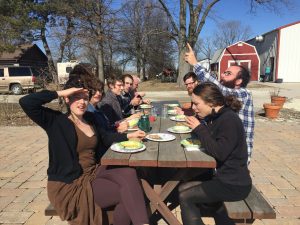This past Saturday the temperature reached nearly 70 degrees. It was our last Central Illinois Farm Beginnings session for the 2015/16 class, and we enjoyed our lunch (prepared with ingredients from local farms) at a long table outside at Prairie Fruits Farm & Creamery, in the sunshine, without our coats on, in February.

There is no denying the smiles on our faces and the excitement about the onset of an early spring. But just underneath the giddy spring-fever feeling, I also felt a bit of anxiety knowing that these beginning farmers are starting their farming careers just as weather events are becoming increasingly severe and erratic.Sitting at that long table with all of the aspiring new farmers who had just finished writing their business plans, I couldn’t help but think about the additional challenges that they will face as the climate continues to change. Farming is full of unknowns, it always has been. But how are the people growing our food going to adapt to climate change, and maybe more importantly, how they will be part of the climate solution?
The Land Connection’s mission states that we “train farmers in resilient, restorative farming techniques…” It is this kind of training, and thinking, that will help new farmers prepare to farm in a way that improves their soils, which will help protect them in times of flood and drought. And as a consequence they will sequester more carbon in their soils. By working with farmers to protect themselves, we are also working with them on becoming part of the climate solution.
So even as I sa


